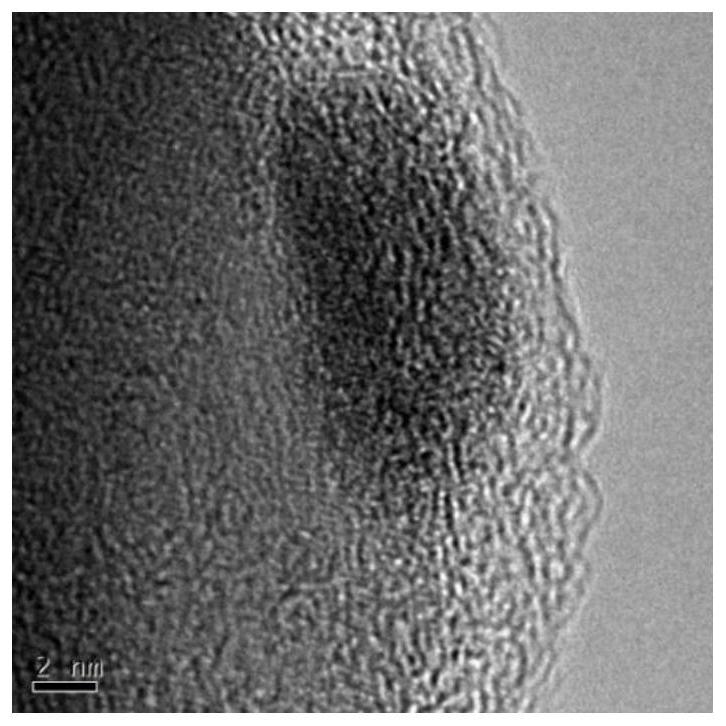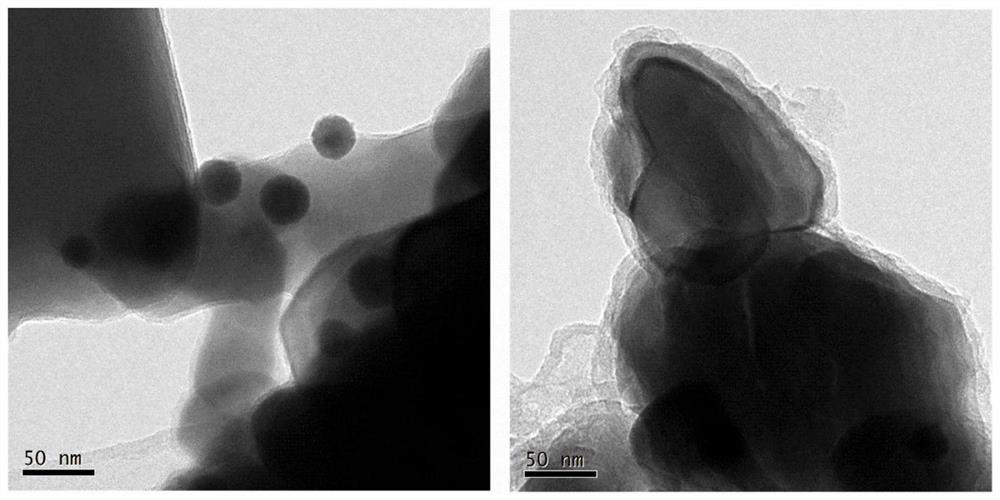Negative electrode material for zinc secondary battery and preparation method of negative electrode material
A negative electrode material, secondary battery technology, applied in battery electrodes, alkaline battery electrodes, negative electrodes, etc., can solve the problem of unavoidable hydrogen evolution corrosion of zinc negative electrode, low battery coulomb efficiency and discharge specific capacity, and reduced zinc negative electrode cycle performance And life and other issues, to achieve excellent cycle performance and Coulomb efficiency, improve discharge specific capacity, and facilitate large-scale industrial production.
- Summary
- Abstract
- Description
- Claims
- Application Information
AI Technical Summary
Problems solved by technology
Method used
Image
Examples
Embodiment 1
[0044] (1) Take 1.165g of zinc oxide and 1.8g of glucose as a carbon source, disperse them in 40mL of deionized water, stir and react at room temperature for 12h, transfer the reacted solution to an airtight container, and keep it warm at 160°C for 4h , after the reaction solution was cooled to room temperature, the solid product was obtained by suction filtration, the product was washed 3 times with absolute ethanol, and dried in a vacuum oven at 80°C for 12 hours to obtain the solid product;
[0045] (2) The solid product obtained in step 1, 0.15 g of soluble metal salt and 1.0 g of additives were dispersed in 40 mL of deionized water, and stirred at room temperature for 12 h. The mass ratio of each component in the soluble metal salt is M1:M2:M3=6:1:1, wherein, M1 is composed of bismuth nitrate and stannous chloride with a mass ratio of 4:0.5; M2 is composed of bismuth nitrate and stannous chloride with a mass ratio of 3:2 Indium nitrate and silver nitrate; M3 is composed o...
Embodiment 2
[0072] (1) Take 1.5g of zinc oxide and 2.3g of glucose, disperse them in 50mL of deionized water, stir and react at room temperature for 14h, transfer the reacted solution to an airtight container, keep it warm at 170°C for 5h, and wait for the reaction After the solution was cooled to room temperature, the solid product was obtained by suction filtration. The product was washed twice with absolute ethanol, and dried in a vacuum oven at 90°C for 11 hours to obtain a solid product;
[0073] (2) The solid product obtained in step 1, 0.19 g of soluble metal salt and 1.3 g of additives were dispersed in 50 mL of deionized water, and stirred at room temperature for 14 h. The mass ratio of each component in the soluble metal salt is M1:M2:M3=6:1.5:1.5, wherein, M1 is composed of bismuth nitrate and stannous chloride with a mass ratio of 4:1; M2 is composed of bismuth nitrate and stannous chloride with a mass ratio of 3:2 Indium sulfate and silver nitrate; M3 is composed of mercury n...
Embodiment 3
[0078] (1) Take 1.75g of zinc oxide, 2.7g of carbon source (glucose and sucrose, the mass ratio is 1:1), disperse it in 60mL of deionized water, stir and react at room temperature for 16h, and transfer the reacted solution to an airtight container within 180°C for 6 hours, and after the reaction liquid was cooled to room temperature, the solid product was obtained by suction filtration. The product was washed 3 times with absolute ethanol, and dried in a vacuum oven at 95°C for 10 hours to obtain a solid product;
[0079] (2) Disperse the solid product obtained in step 1, 0.22 g of soluble metal salt and 1.5 g of additives in 60 mL of deionized water, and stir and react at room temperature for 16 h. The mass ratio of each component in the soluble metal salt is M1:M2:M3=5:1:1.5, wherein, M1 is composed of bismuth chloride and stannous chloride with a mass ratio of 4:2; M2 is composed of a mass ratio of 3: 2.5 indium sulfate and silver nitrate; M3 is composed of mercury nitrat...
PUM
| Property | Measurement | Unit |
|---|---|---|
| particle diameter | aaaaa | aaaaa |
| porosity | aaaaa | aaaaa |
| thickness | aaaaa | aaaaa |
Abstract
Description
Claims
Application Information
 Login to View More
Login to View More - R&D
- Intellectual Property
- Life Sciences
- Materials
- Tech Scout
- Unparalleled Data Quality
- Higher Quality Content
- 60% Fewer Hallucinations
Browse by: Latest US Patents, China's latest patents, Technical Efficacy Thesaurus, Application Domain, Technology Topic, Popular Technical Reports.
© 2025 PatSnap. All rights reserved.Legal|Privacy policy|Modern Slavery Act Transparency Statement|Sitemap|About US| Contact US: help@patsnap.com



